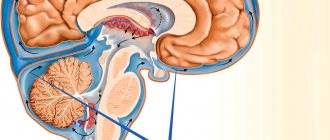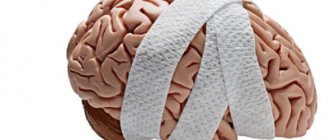Cerebral palsy is a group of diseases in which motor functions and posture are impaired. This is due to a brain injury or a disorder of brain formation. This disease is one of the most common causes of permanent disability in children. Cerebral palsy occurs in approximately 2 cases per thousand people.
Cerebral palsy causes reflex movements that a person cannot control and tightness of the muscle, which can affect part or all of the body. These disorders can range from moderate to severe. There may also be intellectual disability, seizures, visual and hearing impairment.
Accepting the diagnosis of cerebral palsy can sometimes be a difficult task for parents.
Hemiplegic (Hemiparetic) form of cerebral palsy
Right-sided hemiparesis This form is most common. It is expressed in paresis, or paralysis, which covers one half of the body. The arm usually suffers more than the leg. Most patients have mental disorders, reduced intelligence (moronicity, idiocy), but such children are capable of learning and usually adapt to life in society and to work. Children with hemiparesis master age-related skills later than healthy ones. Therefore, the level of social adaptation, as a rule, is determined not by the degree of motor defect, but by the intellectual capabilities of the child. Clinically characterized by the development of spastic hemiparesis (Wernicke-Mann type gait, but without leg circumduction), delayed mental and speech development. Sometimes it manifests itself as monoparesis. With this form, focal epileptic seizures often occur.
There are almost no specialists in the healthcare system for adults with cerebral palsy
Vera Anatolyevna Zmanovskaya , chief freelance specialist in pediatric medical rehabilitation of the Department of Health of the Tyumen Region, chief physician of the State Autonomous Institution "Children's Psychoneurological Treatment and Rehabilitation", Tyumen:
When a person with cerebral palsy goes under medical supervision into the adult network, he finds himself in a so-called “vacuum”, since among adult specialists today, unfortunately, there are few specialists competent in the field of cerebral palsy. An adult neurologist and orthopedist are not “focused” on secondary orthopedic problems of cerebral palsy: the development of these problems in patients begins in childhood and continues into adolescence. But they often have to be resolved after 18 years.
By this age, the patient has a long history that an adult neurologist cannot work with.
There is no need to talk about physical therapists and occupational therapists needed by adult patients with cerebral palsy, since there are catastrophically few of them in Russia. Therefore, often adults with cerebral palsy do not even register at the clinic, because they do not see the point in the assistance that the primary outpatient network provides them.
The second problem in the Russian Federation is the lack of clear interaction between specialists in the pediatric and adult healthcare networks. Often, all interaction consists of a formal transfer of papers - stage-by-stage epicrises that do not reflect the truly existing problems of specific patients with cerebral palsy.
I have no doubt that this is a question for healthcare organizers. In our region, we manage to establish relationships with adult specialists, but, unfortunately, only through personal contacts.
I have been working in rehabilitation since 1992. And, of course, those children with cerebral palsy whom I have observed since the beginning of their professional journey have long since crossed the 18-year mark. I see that when they get to an adult clinic, they do not receive answers to their questions for the reasons listed above.
What questions do they have? The most important thing is orthopedic. It is orthopedic problems that arise just at the age of 16-18 years. Dislocations, scoliosis, deterioration of mobility.
We understand this problem, we see it, and we practically do not let these children out of our sight. They can get advice at our base, for example, from specialists from the Russian Scientific Research Institute named after Academician G.A. Ilizarov”, with whom we cooperate and who, at our invitation, conduct on-site consultations.
And besides, by transferring our patients personally to doctors we know in the adult service, we tell our colleagues what to focus on, what the management protocols were before, and how to avoid past mistakes. We always keep in touch by phone.
But we cannot provide any practical assistance to our patients over 18 years of age (we cannot provide injections, botulinum therapy, we cannot provide rehabilitation services), because we only have a license for pediatric care.
All we can do for them is to build the right route, show them in which direction to move and what to ask for in the adult healthcare system (who needs orthoses, and who needs a good stroller).
Of course, we don’t do it perfectly, like in Sweden or Australia, for example. There, all patients with cerebral palsy are observed without specialization by age, since the state decided to maintain national registers by nosology (types of diseases). Regardless of how old the patient is, he is observed in a qualifying register with the involvement of specialists important to him.
In Russia the situation is more complicated. Despite the fact that in our nomenclature we do not have the medical specialties of a purely pediatric neurologist or pediatric orthopedist (these are general specialties for all ages), a rehabilitation institution as a whole can work with only one category of patients (children or adults), depending on which he has a license.
And, unfortunately, I think that this situation will not be corrected quickly.
Spastic diplegia (Little's syndrome). Tetraparesis with spasticity in the legs.
The most common type of cerebral palsy (3/4 of all spastic forms) is expressed in spastic paresis of mainly the lower extremities. Favorable prognosis for the possibility of social adaptation. The degree of social adaptation with normal mental development can reach the level of a healthy person. Spastic diplegia is characterized by the early formation of contractures, deformities of the spine and joints. Mostly diagnosed in children born prematurely. Pathology of the cranial nerves is common: convergent strabismus, optic nerve atrophy, hearing impairment, delayed mental and speech development, dysarthria, etc., including those caused by environmental influences on the child (insults, segregation). The patient’s psyche suffers, but not as much as in other forms of cerebral palsy. The prognosis for motor abilities is less favorable than for hemiparesis.
Causes
Cerebral palsy (CP) is the result of injury or abnormal development of the brain. In many cases, the exact cause of cerebral palsy is not known. Damage or disruption of brain development can occur during pregnancy, birth, and even during the first 2 to 3 years after birth.
- Possible causes of cerebral palsy during pregnancy or birth may be genetic problems, infections or health problems in the mother or fetus during pregnancy, or complications associated with labor and delivery. Any of these problems can affect the development of the fetus, blood supply, and the provision of the fetus with the necessary nutrients that it receives through the blood. For example, systematic hypoglycemia can lead to the development of cerebral palsy.
- One possible cause of cerebral palsy may be prematurity associated with early birth (preterm birth), and therefore underdevelopment of the brain. Babies born too early are at high risk of bleeding in the brain (intraventricular hemorrhage). A condition called periventricular leukomalacia, which causes damage to the white matter of the brain, is also more likely in babies born prematurely than in those born full term. Both conditions increase the risk of cerebral palsy. • Possible causes of cerebral palsy during the first 2 or 3 years after birth are usually related to brain damage from a serious illness such as meningitis; brain injury due to an accident or brain hypoxia.
Prevention
The cause of cerebral palsy (CP) is sometimes unknown. But certain risk factors have been identified and their relationship with the incidence of cerebral palsy has been proven. Some of these risk factors can be avoided. Following certain conditions during pregnancy can help reduce the risk of brain damage to the fetus. These recommendations include:
- Complete nutrition.
- No smoking.
- Do not come into contact with toxic substances
- Regularly see your doctor.
Recommendations after the birth of the child:
- Minimize injury from accidents
- Determine neonatal jaundice
- Do not use substances containing heavy metals (lead)
- Isolate the child from patients with infectious diseases (especially meningitis)
- Immunize the child in a timely manner.
Double hemiplegia Spastic tetraplegia
One of the most severe forms of cerebral palsy, which is a consequence of brain damage due to intrauterine chronic fetal hypoxia. The cerebral hemispheres or the entire brain are affected. Spastic quadriplegia (quadriparesis, since both the upper and lower limbs are equally severely affected) is diagnosed clinically. Characteristic deformation of the trunk and limbs. In almost half of the cases, movement disorders are accompanied by strabismus, atrophy of the optic nerves, and hearing impairment. pseudobulbar syndrome, epileptic seizures are observed. Such patients subsequently cannot learn to sit, stand and walk; hand defects and lack of motivation exclude self-care and work activity. On the mental side, severe debility, imbecility, and idiocy are noted.
“Where did you get a job with such and such a diagnosis?!”
Yana Kuchina , 30 years old, editor, journalist, person with cerebral palsy:
In a person with cerebral palsy (even the very name of this diagnosis is deceitful: it is not “childish”; this condition remains with the person for life), no matter how successful the rehabilitation is, deterioration may occur. You don’t need a great reason for this, like an accident or a compound fracture; it’s enough to get sick with the flu for a long time, wear bad shoes, suddenly gain twenty kilograms, or just get old.
And we have to remember again about rehabilitation, even for those adults who did without it. The local neurologist knows little or very little about cerebral palsy and will only help with a referral to the nearest specialized government agency.
At one time I got what was next to Tsaritsyn Park, at my place of registration. It is impossible to choose any other establishment, even within your city or region.
I was “treated” for three months and it didn’t help? So you're not trying hard!
These institutions do not provide consultations; there is no way to get a set of exercises to take home or a list of procedures that you could spend one and a half to two hours a day on. Do you want to be treated? Get hospitalized! Once a year, the state will pay for a course of treatment for something that cannot be cured. Hospitalized for at least a month. An extract is necessary to extend disability and receive all benefits and benefits.
It doesn’t matter that you may have school, or work, or family. Firstly, they explain to you right from the start that health is more important, and secondly, how can you have a job, study or family with such and such a diagnosis?
Then you are slowly prescribed procedures. Massage - ten times, therapeutic exercises in a group, magnets, mud and anything else, depending on your luck. This helps a little. Well, that is, you sat at the computer for eight hours a day, and then you started walking according to a schedule, eating unsalted food, swimming in the pool, doing bends in the gym. If I had gone to this institution as a healthy person, I would definitely have felt better within a month. But this, as we understand, is not my case.
Okay, let’s say specialists can be retrained. Replace the procedures, redo the daily routine, replace exercise therapy with classes with physical therapists who know the Feldenkrais method, Vojta, and who develop original methods. It’s unclear how miraculously this could happen, but let’s say.
What if I still have a job? If I was hired under the Labor Code, I pay taxes, support my family and my vacation is two weeks in a row, no more? Should I quit my job? What if I felt bad not once a year, but twice? If I have small children, I would be happy to live for two weeks on tasteless food and government-issued bedspreads, but I can’t. What if I just want to go to the sea on my vacation? All? I can’t wish for this, with such and such a diagnosis? And what should I do when I’m discharged home, and a month later my back or heel hurts so much that it’s difficult to sleep? Where can I get help?
I am studying physical therapist courses, we are studying the Feldenkrais method. It is not like the gymnastics that everyone is used to: “Raise your right leg as high as possible, repeat a hundred times; raise your left leg...” The Feldenkrais Method works by creating new neural connections. Simply put, we teach our brain to move. It is common to think that movement is a common, natural good and does not need to be specially studied. But anyone who has spent time with young children knows that a child is constantly learning to move.
The child tries to hit the blanket with his hand a hundred times in a row, reach for the red thing, reach for the cat. First he learns to raise his head, then to crawl, then to sit, stand against the wall, and then he lets go of his hands and takes the first step - twelve months after birth. After twelve months of daily continuous training.
People with cerebral palsy cannot move. The brain injury prevented the movement learning process from starting on its own. They also want to grab food, scratch their nose, but they don’t know how and won’t learn without help. Feldenkrais physical therapists teach people to move in a variety of ways so that the human brain can independently choose the best way, the easiest and most effective. We all choose almost the same thing, which is why we walk almost the same way.
During classes using the Feldenkrais method, people do not repeat the same movement a hundred times, which they no longer succeed in, as with exercise therapy. People learn to do this movement. That's the difference.
Ideally, every adult with cerebral palsy should be seen by a physical therapist and they should plan rehabilitation together. There are periods in life when it is not needed at all, everything works and nothing hurts, but you still have to get into such a period.
Course rehabilitation, i.e. Rehabilitation once a year or once every six months, even if effective, is not suitable for a person with cerebral palsy, because the acquired skills are quickly lost, and in fact, you start over again every time. Well, if you were lucky, then again, and if there was a deterioration over the year, then I’m sorry.
Now you are even more terminally ill, congratulations!
In addition, each person has his own potential and character. Some people are ready to train for an hour a day, while others have a hard time with ten minutes. And everyone's desires are different. Some people drive a car and don’t suffer at all because they can’t ride a scooter to the Danilovsky market; others have been dreaming of skiing for forty years and don’t know that, in principle, it’s possible. You just need a special coach, here is his WhatsApp number. The most important thing, in my opinion, is to integrate a support system into everyday life, to make it accessible, like McDonald’s, so that a person can maintain his health without stopping living.
Medical rehabilitation of patients with cerebral palsy
In addition to clinical, laboratory, functional diagnostics and physiotherapeutic methods of recovery, treatment includes the selection of medications. In the case of cerebral palsy, the main goal of drug therapy is to control seizures, relieve muscle spasms and pain.
For each patient undergoing rehabilitation after a stroke, traumatic brain injury or cerebral palsy, an individual drug therapy plan is selected based on the clinical recommendations of specialized doctors at our center.
Video: Neurochat helps patients who cannot speak!
The innovative Neurochat program has become an excellent assistant for patients who are unable to clearly express their thoughts. Already today, the new system is actively being introduced into the processes of rehabilitation after traumatic brain injuries, stroke, cerebral palsy and multiple sclerosis. The first clinical trials of the Neurochat system took place in a rehabilitation hospital on October 10, 2021.
Detailed information on the cerebral palsy rehabilitation program, necessary documents and available dates for the patient’s admission - call +7(495) 128-77-43










